Duration
Amadablam Base Camp Comfort Trek
From $3,700 pp
Bookable From
September - November March - May
Trip Style
Privately Guided
Country
Nepal
Physical Rating
Average
Overview
Trek in comfort and soak in breathtaking views along the Amadablam Base Camp path in the awe-inspiring Everest region of Nepal's Himalayas.
This trip provides the opportunity to walk at your own pace while enjoying captivating views such as Everest soaring above the Nuptse Ridge, the incredible peak of Ama Dablam, and other neighboring peaks. You will also get to immerse yourself in the culture of the local people, and try out the regional cuisine to discover new tastes, flavors, and textures.
Highlights
- Visit the magnificent ancient religious architecture and center faith of Hinduism and Buddhism.
- Hike with stunning views of glaciers and mountains such as Everest, Lhotse, and Nuptse.
- Take part in the Mani Rimdu festival and see the monks and the Lamas dressed in colorful dresses with elaborate masks.
- Immerse in Nepalese traditions and learn about the culture of the Sherpas.
- Visit the first school built by Edmund Hilary, one of the first two individuals to successfully summit Mount Everest, who also worked to improve the lives of the Sherpa people in Nepal.
- Explore the untouched village of Thame to be amazed by its buildings and culture.




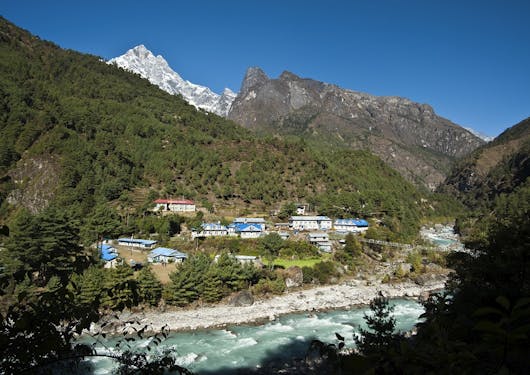

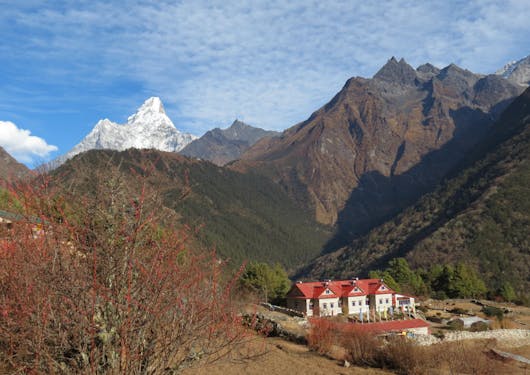


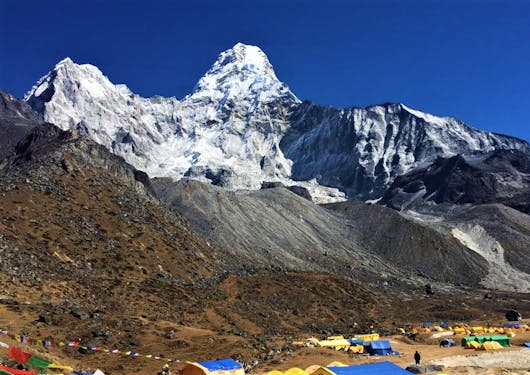
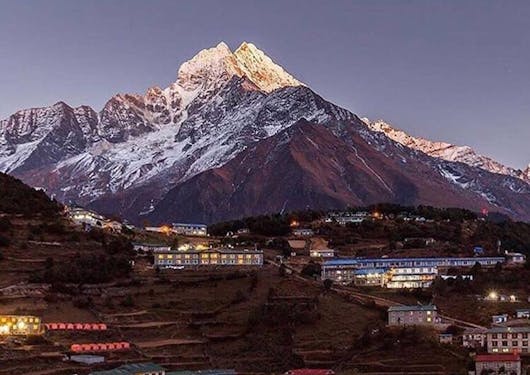
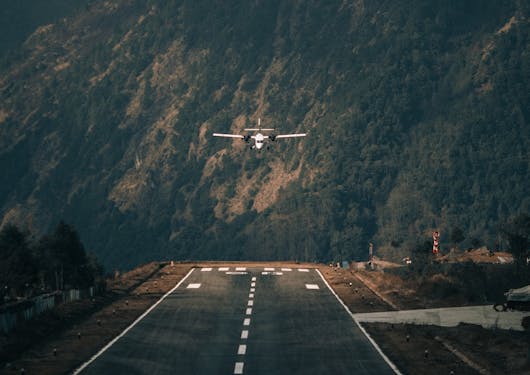
What makes this holiday even more charming is the Mani Rimdu festival, held on the tenth Lunar month of each year. This, as well as other cultural activities, allows you to connect with local communities and a different way of life.
What is so special about the Mani Rimdu festival?
The Mani Rimdu festival is a unique and fascinating celebration that offers a window into the rich cultural and religious heritage of the Sherpa people of Nepal. This vibrant event is a time of spiritual renewal, community building, and cultural celebration, and it features a wide range of religious gatherings, songs, dances, and enactments of legends that are sure to captivate anyone who attends.
In addition to its cultural and spiritual significance, the Mani Rimdu festival is also a celebration of the breathtaking natural beauty of the Khumbu region of Nepal. The festival is held against the backdrop of the stunning Himalayan mountain range, and attendees have the opportunity to explore the area and experience the beauty of the region firsthand.
Our multiple hikes offer great chances to see picturesque villages as well as local fauna and flora. Rejuvenating and invigorating, this holiday adventure will be a lifetime experience you would not want to miss. Don't worry about your safety, our trek is designed in such a way that allows proper acclimatization. You just have to enjoy it, are you ready?
Seasonal Notes
Autumn (September-November) is the ideal season for trekking. The temperatures are moderate with clear skies and enticing mountain vistas. Additionally, trekkers can get the opportunity to explore local people's festivals and culture because these months are festive seasons when most Hindu festivals in Nepal celebrate grand festivals like Dashain and Tihar.
Spring (March-May) is also great season for trekking and climbing. It offers a diverse range of wildflowers blossoming that create a real paradise. The weather is mildly warm at lower altitudes and there are quite moderate temperatures at higher elevations over 4000 meters.
Itinerary
Day 1 Kathmandu [Nepal] (arrival day)
Day 2 Cultural Introductory Tour - Drive to Mulkot
Day 3 Start trek. Ramechhap - Lukla: Hike to Phakding (~4-5 hrs)
Day 4 Phakding - Namche Bazaar (~6-7 hrs)
Day 5 Namche - Tashinga (~5-6 hrs)
Day 6 Tashinga - Pangboche (~5-6 hrs)
Day 7 Pangboche Excursion or (Optional: Hike to Amadablam Base Camp, ~4-5 hrs)
Day 8 Pangboche - Tashinga (~6 hrs)
Day 9 Tashinga - Monjo (~5-6 hrs)
Day 10 End trek. Monjo - Lukla (~5 hrs)
Day 11 Lukla - Ramechhap - Kathmandu
Day 12 Buffer Day
Day 13 Kathmandu (departure day)
Route Map
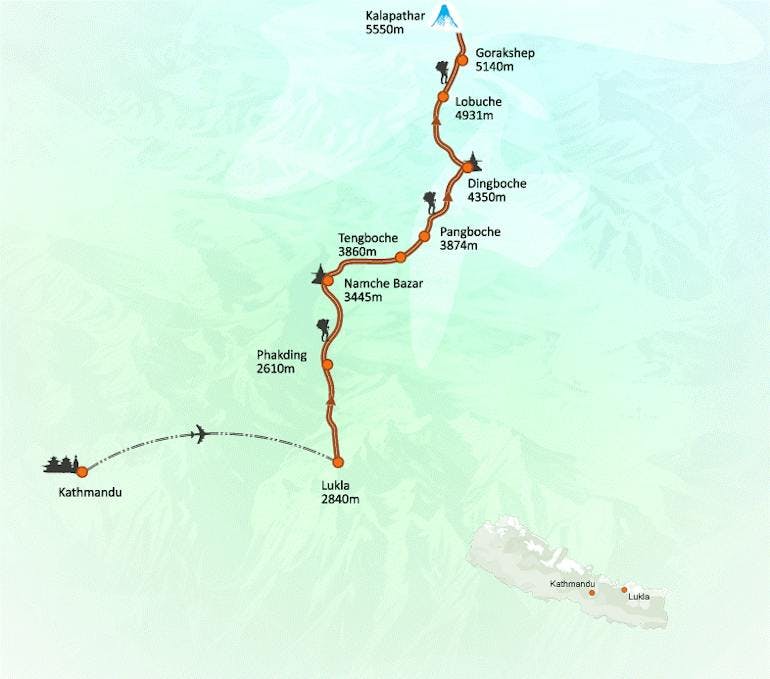
Inclusions & Exclusions
3-nights hotel in Kathmandu with breakfast
1-night hotel in Mulkot with breakfast
8 nights in comfort accommodations throughout the trek on full board
14 Breakfasts, 10 Lunches, 10 Dinners
Domestic flight from Ramechhap-Lukla-KTM
Private transfer to/from Ramechhap
Private airport pick-up and transfer
Half-day Sightseeing in Kathmandu (Day 2)
National Park fees
Trek permits
Any meals not mentioned as covered above and in the itinerary
Tips
Travel Insurance
Liability Insurance
Beverages
Personal equipment
Visa fee: US $30 for 15 day, US$50 for 30 days, and US $125 for a 90-day, multiple entry visa
Any activities not mentioned in itinerary
Excess baggage beyond 15 kilo including day pack
Pricing
Prices exclude flights to/from the destination.
Prices are for double room occupancy unless indicated otherwise.
Contact us for pricing if your group has more than 10 travelers.
Deposit per person
30% of trip price
Solo Traveler
$5,050
Group of 2-4 Travelers - price per person
$3,850
Group of 5-10 Travelers - price per person
$3,700
Single Supplement
$1,400 (if traveling with a group and you prefer a private room)
Payment & Cancellation Policy
This trip is available from September to November and from March to May.
At checkout, choose your preferred departure date and pay the deposit. Yugen Earthside’s standard Payment & Cancellation Policy applies.
Book With Confidence
- Your deposit is fully refundable for 30 days when you book 120+ days in advance and pay by bank transfer.
- If you pay by credit card, the card processing fees are non-refundable.
- We’ll confirm availability for your chosen dates within 3 business days. If confirmed, you’re all set! If not, we’ll help you adjust your dates or refund your deposit.
Sustainability
Our company is Travelife certified, and we are committed to minimizing our negative impact on the environment and society. To achieve this, we work with our business partners such as accommodation providers and excursion providers to encourage the adoption of sustainable practices. We also create awareness among our guests and staff about the importance of sustainability. We believe that by promoting sustainable tourism, we can contribute to the preservation of natural and cultural resources for future generations.
- Environmental Initiatives
We have taken various measures to reduce our carbon footprint. For example, we encourage guests to bring reusable water bottles and water filter tablets to reduce plastic waste. Our guides also collect trash along the trail and dispose of it in designated areas. During the trip, we avoid plastic-related items as much as possible, and we use cloth bags instead. Additionally, the trip is centered around trekking, which is a low-carbon impact activity. Our accommodations, including hotels and mountain lodges, are environmentally friendly, and most electricity and heating are generated by solar power and village electricity schemes.
Lastly, our office is an example of our economic practices, where we prioritize the use of sustainable products. We use biodegradable hand soap and cleaning powder, which are handmade and hand-packed by women from poor, remote communities. The office is solar-powered, and we use energy-efficient lights and water-efficient toilets. By incorporating sustainable practices in all aspects of our operations, we aim to promote responsible tourism that benefits both the environment and society.
- Sociocultural Initiatives
We support the local community in various ways. The mountain lodges we use are made by locals with local materials, and they employ locals as staff. These lodges serve organic meals prepared from local produce and ingredients, catering to guests' dietary requirements such as vegetarian and vegan. The trip also includes hiking through villages, providing guests with an opportunity to interact with locals and witness their traditions and way of life.
Health & Safety
Be sure you have traveler's insurance.






Reviews
Maja K.
Oct 31, 2025
Everything was great and we had a wonderful time!
We had such a wonderful time in Nepal! Yugen Earthside truly understands the ethical aspect of traveling, recognizing the importance of the protection of animals and cultures. We recommend them to everyone who wants to experience something authentic and unique. I absolutely loved the organisation, response time, and everything else about the company! I believe they reflect my ideals and my care for the planet and conscious traveling.
Our favorite parts about the trip were the hike to Nagarkot and the Patan visit. The local Nepali partner was perfect; we were so taken care of, it made us feel so happy!